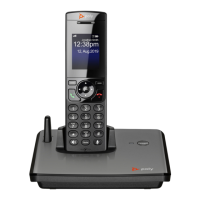Call Routing
35
Note that the curly braces can be omitted if there is only one rule in the route. The OR operator isn’t part of
the parameter syntax. It is used here to separate alternative values only.
A rule has the following format:
rule := callee-list : terminal
where
● callee-list:= callee|callee|callee| …(vertical bar separated list of 0 or more callee
object)
● callee:= number OR embedded-digit-map OR @ (@ = any number)
● terminal:= DTx OR SPx(arg) OR PPx(arg) (arg object is optional)
● arg:= cid > target
● x:= 1 OR 2 OR 3…(where applicable. Can be omitted x = 1.)
● cid = spoofed-caller-number
● target = number-to-call OR $2
● embedded-digit-map = (Mlabel) OR digit-map
General notes:
● A terminal can be a trunk or another endpoint.
● Abbreviated terminal names are case-insensitive.
● Number and number-to-call are literal strings, such as 14089991234.
● Digit-map is just any proper digit map, such as (1xxx|xx.). Make sure to include the enclosing
parentheses.
● Spoofed-caller-number is a literal string, such as 14081112233, to be used as the caller
number for making a new call on the specified trunk.
● (Mlabel) is a named digit map where label is the abbreviated name of any terminal that has a digit
map defined: SP1, SP2, LI, PP or DT.
● $2 is an internal variable containing the called number of this outbound call, after any digit map
transformation in the matched callee object.
● Callee-list can be empty, which implies the single callee object @, which means any called
number. The succeeding ‘
:’ can be omitted also when callee-list is empty.
Notes on the arg, cid, and target objects:
● The cid object inside an arg object is optional. If omitted, it implies no caller-ID spoofing when
making the call on the specified trunk. The succeeding ‘>’ can be omitted if cid is omitted.
● The target object inside an arg object is optional. If omitted, it implies the target $2, which means to
call the original called number after applying any necessary digit map transformation implied by the
rule. The preceding ‘>’ can’t be omitted if target is omitted but not the cid.
● arg object is optional. If omitted, it implies the arg with the target $2 and no cid.
An outbound call matches a rule if its called number matches one of the callee objects of the rule. Callee
objects are tested in the order left to right, and the first matched callee wins. Rules are also checked in the
order left to right, and the first matched rule wins. Therefore it is important to place the more specific rules
first in the OutboundCallRoute if multiple rules can potentially match the same outbound call.
Note that every endpoint also has a digit map defined. The user-dialed number is completely processed with
the endpoint’s digit map first before it is passed to the OutboundCallRoute for a routing decision. Therefore

